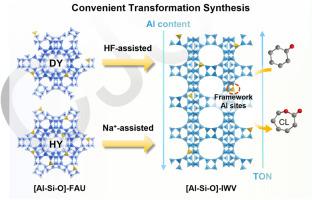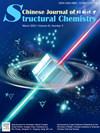Convenient transformation of FAU zeolites to IWV aluminosilicates with adjustable Al sites for Baeyer-Villiger oxidation
IF 10.3
4区 化学
Q1 CHEMISTRY, INORGANIC & NUCLEAR
引用次数: 0
Abstract
The Baeyer-Villiger (BV) oxidation of cyclohexanone is explored using IWV-type aluminosilicates with different Al sites as heterogeneous catalysts. The IWV framework exhibits a two-dimensional 12-membered ring (MR) pore system intersected by 14-MR supercages, resembling typical beta zeolite. To address the constraints associated with hydrothermal synthesis, IWV aluminosilicates were synthesized via interzeolite transformation of various FAU-type zeolites. HF-assisted transformation of dealuminated FAU zeolite resulted in the formation of a high-silica IWV aluminosilicate (Si/Al = 54.6), whereas the incorporation of aluminum isopropoxide enables the tuning of Si/Al ratio down to 18.7. The alkaline conversion of protonated FAU zeolites, utilizing Na+ ions as mineralizing agents, produces high-Al content IWV derivatives in just four days. Catalytic evaluation demonstrates that the high-silica IWV catalyst exhibits a higher turnover number than the other IWV catalysts, along with enhanced ε-caprolactone (CL) selectivity relative to that of high-silica beta zeolite. Facile modifications are performed to adjust Al sites, as characterized by pyridine-adsorbed infrared spectroscopy. Experimental evidence confirms that Al Brønsted acid sites improves the selective oxidation of cyclohexanone, while concurrently enhancing CL hydrolysis.

FAU沸石为Baeyer-Villiger氧化用铝位可调IWV铝硅酸盐的便捷转化
以不同Al位的iwv型硅酸铝为催化剂,研究了环己酮的Baeyer-Villiger (BV)氧化反应。IWV框架具有二维12元环(MR)孔系统,由14-MR超笼相交,类似于典型的β沸石。为了解决水热合成的限制条件,通过各种au型沸石的沸石间转化合成了IWV铝硅酸盐。脱铝FAU沸石的hf辅助转化形成了高硅IWV铝硅酸盐(Si/Al = 54.6),而异丙铝的掺入使Si/Al比降低到18.7。质子化FAU沸石的碱性转化,利用Na+离子作为矿化剂,在短短四天内产生高铝含量的IWV衍生物。催化评价表明,高硅分子筛比其他分子筛具有更高的转化率,且相对于高硅分子筛具有更高的ε-己内酯(CL)选择性。用吡啶吸附红外光谱对其进行了简单的修饰以调整Al位。实验证据证实,Al Brønsted酸位改善了环己酮的选择性氧化,同时增强了CL的水解。
本文章由计算机程序翻译,如有差异,请以英文原文为准。
求助全文
约1分钟内获得全文
求助全文
来源期刊

结构化学
化学-晶体学
CiteScore
4.70
自引率
22.70%
发文量
5334
审稿时长
13 days
期刊介绍:
Chinese Journal of Structural Chemistry “JIEGOU HUAXUE ”, an academic journal consisting of reviews, articles, communications and notes, provides a forum for the reporting and discussion of current novel research achievements in the fields of structural chemistry, crystallography, spectroscopy, quantum chemistry, pharmaceutical chemistry, biochemistry, material science, etc. Structural Chemistry has been indexed by SCI, CA, and some other prestigious publications.
 求助内容:
求助内容: 应助结果提醒方式:
应助结果提醒方式:


